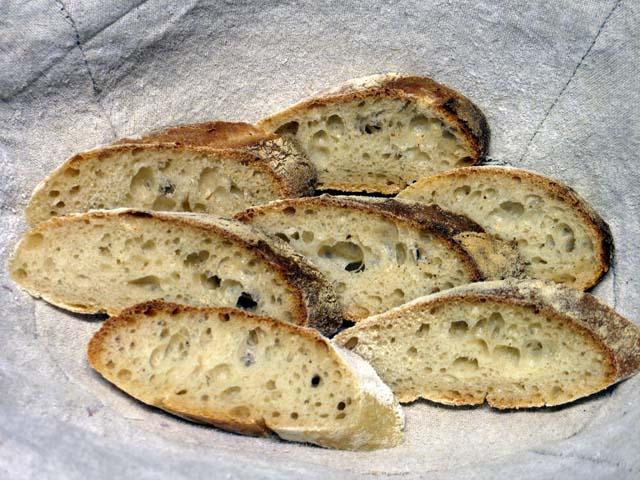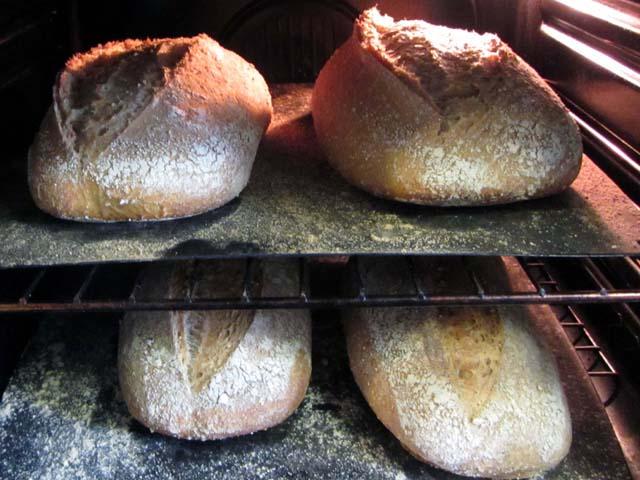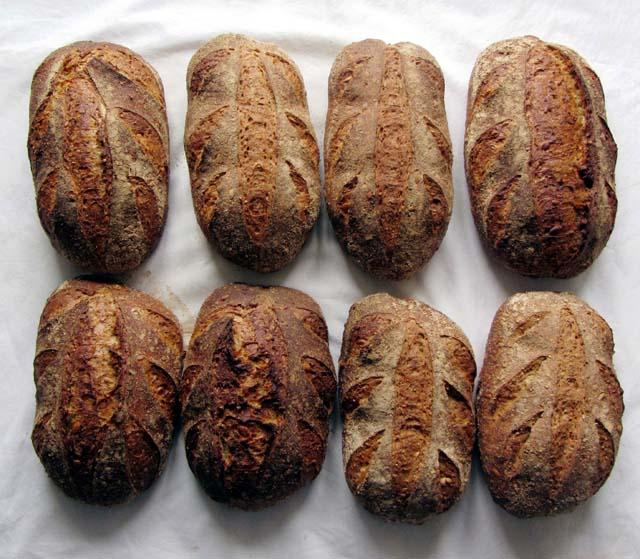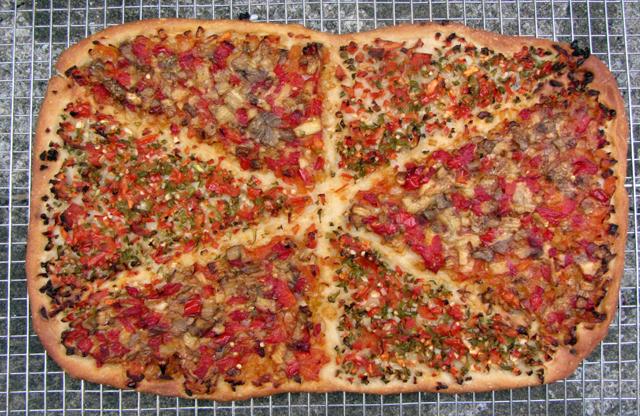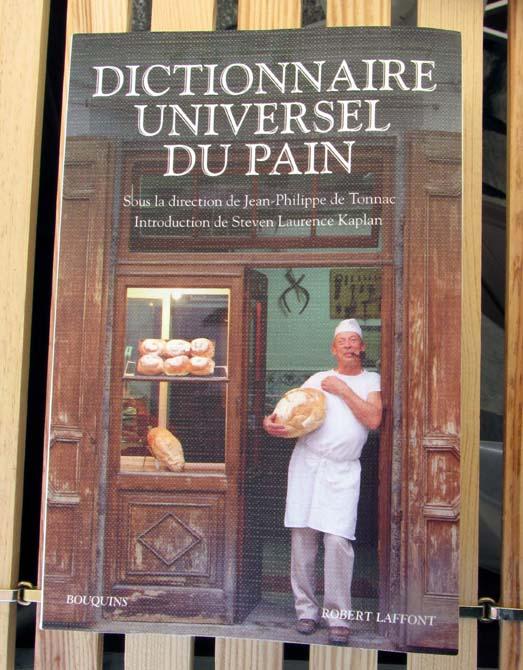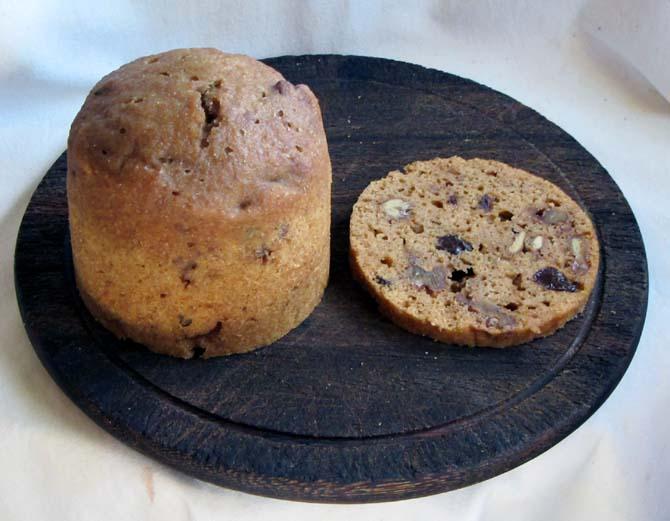
bethesdabakers
participating member-
Posts
239 -
Joined
-
Last visited
Content Type
Profiles
Forums
Store
Help Articles
Everything posted by bethesdabakers
-
Professor Calvel was writing for commercial bakers using deck ovens. I don't think I went wrong anywhere. If you are talking about the likes of baguettes .... The steamless baguette:
-
The ones baked with steam are the top four. I only bake sourdough and these are 5 Seed with Spelt so you're not talking about a light dough. Below are Multigrain - 50% Strong White Bread Flour/50% Wholemeal + a soaker of millet, jumbo oats, bulgar & polenta - so, again, not a light dough. Baked without any steam. So, from the photos can you tell me why I would want to use steam? You'll find dozens of bread photos on the blog all baked without steam. Am I going wrong somewhere?
-
As you say "on topic". I've been waiting to see all these examples of how steam (generated by rocks, chains, whatever) improves bread. Nothing forthcoming. So here's a question. Which four of these loaves was baked with steam? (The steam in this case generated by a plant mister - 3 squirts each top left and right against the walls of the oven, same middle and bottom.)
-
Hi Linda The marinade had an unusual and beguiling flavour but because it was very spare it was quite patchy. I thought that next time I made it I would increase the lemon juice a little and maybe soak the saffron in it for a while prior to marinating the fish. The flavour of the saffron came and went in a teasing sort of way. Will definitely be making it again. Mick
-
I'Ve really been enjoying this thread and finally have something to bring to the feast. By and large, buying salt cod means an 80 mile trip to Liverpool so it remains something of a treat. By and large, I like accra de morue so much that that's what I cook. And like pizza, photographs are difficult to take because the food doesn't get time to stand around posing. Was doing a tapas meal for friends, had salt cod in the fridge (the fresh salted rather than the dried board variety) found a recipe, Soldatitos de Pavia, in Pennelope Casas book "Tapas". After soaking, the fillets are skinned, dried and placed in an interesting little marinade - juice of half a lemon, couple of thin slices of onion, a clove of garlic crushed, chopped parsley and a few strands of saffron. Make a batter - 3 quarters of a cup of flour, teaspoon & a half of baking powder, bit of salt, quarter cup of milk + the same of water + 3 tablespoons veg oil. I found this a bit too thick and dilluted it a little. Scrape off the marinade, cut the fillets into fingers, flour, dip in the batter and deep fry until golden. Very interesting flavour and just fabuloso. Mick
-
So you're a mathematician. Of two earlier mathematician/bakers one created a dozen made up of thirteen and the other a system of percentages totalling more than one hundred. Third time lucky .... I hope that by the end of this thread you have developed a formula for rating ovens by the number of links of chain required to produce the optimum amount of steam. Have to have a standard metal, bar thickness, link diameter, etc - a factoring for altitude? Links by oven litre? Maybe the units could be called bagels ... You can do it! The reason you can't come up with anything on steam linked to thepartisanbaker is I don't use steam (apart from naturally occuring)so I don't write about it. By the way, the use of the word partisan is to do with the total debasement of the word artisan in relation to bread and bakers not to taking a narrow and fixed position. Don't worry I shall be posting Mick's No Nonsense Method soon so you can have a pop back at me. Best wishes Mick
-
On the other hand ... My blog, The PArtisan Baker, is subtitled "Taking The Bollocks Our Of Baking". I'm thinking of changing this to "Bakers of the World Unite; You Have Nothing To Lose But Your Chains" Mick
-
Well, the story did end up north of Gare du Nord - in Liverpool. See here Had a great weekend in Paris but it rained as bad as North Wales. We walked for miles but among the ethnic shops we never came across anything North African. But thanks again for the suggestions - we made plent of new discoveries. Mick
-
Bethesdabakers Works Outing (me and herself) to Lunya in Liverpool last week. Cold and damp, stepping between the stalls of a rarther sparse Christmas market, came upon a large embroidered tent in the gloom of Church Alley leading down to the Bluecoat. Nearly walked past thinking it to be another load of old tinsel when I noticed it was full of heaps of hundreds of tagines - different shapes, colours and designs. Real, serious tagines for cooking in. My current No.1 pot has a crack - it might last for years but it might not so this is like landing in heaven. Bought the big unglazed one straightaway - £10 reduction for being the first customer of the day. Of course, after a great two-bottle lunch at Lunya, walked back and found excuses for buying the two semi glazed pots. The midget is in lieu of a pound coin the vendor was short of in change. He's back to Morocco in several days time so if you are interested in these cooking machines Church Alley should be your destination. Mick
-
Thanks, I should have thought of that but normally would be heading into the centre from Gare du Nord, probably directly onto the metro without leaving the station. Mick
-
Off to Paris next weekend for the first time in a couple of years. Apart from having a good time, celebrating aniversaries, etc. my chief interests are bread and food related. I know the main kitchen shops and Librairie Gourmande, and I've done the famous boulangeries but does anyone have any suggestions or personal favourites or new arrivals in these fields? Plus, this time we're not flying, so can stagger back on Eurostar with a decent tagine in addition to the Martinique rum. Where's the best place reasonably near the centre to find North African cookware? Thanks Mick
-
I wasn't going to buy a new cook book but then along came Claudia Roden The Food of Spain and the page opened at Coca. This is a combination Coca de Recapte with a base of precooked onion and tomato, topped with red pepper and aubergine - again pre-roasted - and Coca de Trempo from Majorca using chopped raw green pepper, onion and tomato. I used a white sourdough base at 78% hydration that had been fermenting for a couple of days in the fridge. Baked at 180C for 40 minutes. Mick
-
If you're quick you can have grouse in Caernarfon this weekend at Oren, 26 Hole in The Wall Street, 01286 674343 - just over the road from the castle. I've been meaning to post information about Oren for months - what other restaurant changes its menu every week, charges £15 for three courses, £12 for a bottle of wine and has a reading group? I declare an interest; I supply them with bread - only six loaves a week so this post is unlikey to benefit me greatly. The menu taken from the restaurant's email to customers: "This week sees another diversion from Oren basics, as the price for the set menu will be £18.50!. Dont worry, it is for one week only and it is to do with the price of the grouse. It is the end of the short grouse-season, and I have ordered some straight from Scotland. Hence a menu otherwise heavily influenced by honey and whisky. 27/28/29 September: The Famous Grouse Menu Duck & Celery Soup Lentil & Whiskey Pate Honeyed Grouse on Toast Curried Mussels with Cauliflower Honey Roasted Squash with Wild Mushroom & Whiskey Sauce served with Red Cabbage & Potato Gratin The Famous Grouse Chocolate & Raspberry Ball" Mick
-
High Gluten Flour in the UK
bethesdabakers replied to a topic in United Kingdom & Ireland: Cooking & Baking
Hope you aren't thinking about making bread with that stuff - there are other solutions! Mick -
Independent and self-published cookbooks
bethesdabakers replied to a topic in Cookbooks & References
Thanks Sylvia. Having googled it I can now add bupkis to my vocabulary. Mick -
Independent and self-published cookbooks
bethesdabakers replied to a topic in Cookbooks & References
TBOB (Taking the Bollocks Out of Baking) is much needed. It wasn’t me who called your low-carb diet stupid. I would sue the estate of Robert Atkins for obstructing trade (or whatever the correct term is) but I don’t sell enough books to be able to afford to sue because everyone is on a low-carb diet. (I see he once thought of becoming a comedian.) Also, I won’t take part in the dumbing down race (Sourdough Made Simple in Only 3.5 Minutes a Day?) I see we now have a Healthy Bread in Five Minutes a Day. Does that mean the bread in the first book was unhealthy? Another reason my book is self-published and approaching 250 sales while these books have bona fide publishers and sell by the thousand. Revolutionary thought but every consider coming off the low-carb diet, buying the book and baking the bread? Your husband doesn’t have to eat it. Best wishes Mick -
What is there to compare it to, Matthew (serious question)? Given the dearth of good bread books, 1000+ pages of information with entries by bakers from around the world is a pretty wonderful thing, regardless of whether some of it is patchy or eccentric. A little dangerous to claim an “Index de tous les pains des monde” and even a brief skim showed up at least one spelling mistake (bram bread) but where’s the competition? And it will give my French a severe stretching. I’m quite used to being in a minority of one in believing that a bit of commercial yeast in an otherwise naturally leavened bread is totally misguided – there are around thirty recipes in the book by eminent international bakers none of whom seem to agree with me – so I tend to “interpret” what I read anyway. It will do me for the time being. Mick
-
Didn't find much to grab me in France this year. I was amazed to find two new UK bread books translated and published in French editions. Are they losing their confidence? With the Olympics and the queen's jubilee there are acres of Buckingham Palace cookery books, and food in London is suddenly in fashion, but bread? Then I found this gem at the Bordeaux Fete du Pain: Dictionnaire Universal du Pain - Jean-Philippe de Tonnac - Bouquins - ISBN 978-2-221-11200-7. I cheated and ordered it from Amazon UK when I got back. With over 1000 pages of information it should keep any budding baker quiet for a very long time especially if their French is anything like mine.
-
Independent and self-published cookbooks
bethesdabakers replied to a topic in Cookbooks & References
I’m sure there is nothing “inherently better about indie/self-publishing” apart from an artisan satisfaction of having produced it yourself. Success is covering your cost; major success is being able to afford a reprint. If your subject is bread and (in the UK) your name is not Dan Lepard, Hugh Fearnley-Whittingstall or work from the School of Artisan Food you are not likely to find a publisher. If your subject is naturally leavened bread, no matter how good it is – forget it. Even with a “celeb” name no publisher is interested. Although there hasn’t been much response to Justin’s original post, there are likely to be any number of excellent self-published books out there especially on “minority” interests in food preparation. The problem for the author is bringing them to the world’s attention. So, as well as self-publishing, I would like to self-recommend “Bethesdabasics – Sourdough Made Simple” because I honestly think it’s the best basic book available on the subject - http://thepartisanbaker.com/shop/ - plenty of customer response on the blog. It won’t make me rich if you buy it. But think, £600 would let me print my next book on how to set up and run a microbakery. That means more bakers in the world baking good bread one of whom might set up in your neighbourhood … Mick -
Can't help you with bakers in Beaune - don't know that part of France. But I do know and spend time in big chunks of France and although, of course, there are still great bakers in France, the sad fact is that probably 95% of French bread is mediocre or awful. I'm not talking about patisserie, but I know of excellent patisseries that produce awful bread. Lucky me, I'm just going to Arcachon for a month - I shall take my own starter and for the most part will be baking my own bread. We've been going there for 30 years and so know the Basin d'Arcachon area and Bordeaux very well. I can only tell you of one baker (le Fournil des Boiens in Biganos) that I would bother to buy bread from. For the most part boulangeries use frozen or chilled doughs or premixes - a few proudly announce that that their dough is mixed and baked on the premises as if we should be impressed by this. I love France and its baking tradition but it has been living on its past reputation for too long. Mick
-
Morrisons – time to give it a try
bethesdabakers replied to a topic in United Kingdom & Ireland: Cooking & Baking
How many of the superb range of breads did you try? Mick -
Haven't made any progress on the historical side of matters.But a restaurant I supply bread to is having a New England week so I finally got round to trying Janeer's Boston Brown Bread recipe. This is a test bake. came out too small for the tin, is pale because I had to substitute golden syrup for molasses, but is quite delicious The hardest part was, as usual, converting cups to metric weight. The final weights for a UK 250g coffee tin work out at: Wholemeal Wheat Flour 99g Cornmeal 40g Wholemeal Rye 40g Salt 2g Baking Powder 2g Egg 29g Molasses 99g Buttermilk 235g Walnuts 29g Raisins 58g (unsoaked) Water (for soaking raisins) 47g + a splash of whiskey Steaming time was about 2.5 hours Thanks you Janeer
-
I’ve tried to post this recipe at least three times before with photos as beautiful as Xilimmns but they always get eaten before the camera comes out. Happened again last Friday evening when we had friends to dinner. Accra, based on a recipe from Creole Caribbean Cookery by Kenneth Gardinier. About 340g salt cod soaked for 24 hours +. Drop into boiling water and turn off the heat. When cool flake and discard the skin. Finely chop about 4 spring onions, 2 cloves garlic, a scotch bonnet and mix with the fish. Sift about 140g flour and mix in a teaspoon of baking powder, a teaspoon of curry powder, salt and pepper to taste. When you are ready to cook mix the flour mixture into the fish mixture, stir in enough water to make a paste. Shallow fry spoonfuls of the mixture until well browned on all sides – mine are ragged compared with Xilimmns perfect shapes. Serve with Floats, the Trinidadian fried bread. I don’t use commercial yeast so I did a sourdough version which you can find here if you are interested. If not take a basic white bread recipe but rub butter (or lard) into the flour, about 30% of the flour weight. After your usual fermentation period, scale the dough at 60g, pat out into rounds about 4 inches in diameter. Fry for three minutes on both sides. They come out like very light puff pastry. Mick
-
Hi Linda Finding good beginners bread books in any language isn’t easy (which is why I ended up writing my own sourdough (pain au levain) primer, link here). Anyway you made me dig out my French bread books. This needed doing - over twenty so far and there are still some hiding. Each time I go to France there seems to be no end to the nondescript small bread books that come and go usually aimed at bread machine owners. A couple of quite reasonable examples for beginners are: Le Pain Chez Soi – Andre Rival – Editions France Agricole Tous les Pains – Basile Kamir – Hachette Pratique If you buy Le Guide des Boulangeries de Paris – Augustin Paluel-Marmont & Michel de Rovira, you can check out a couple of Basile Kamir’s bakeries. For pain au levain, Apprendre a faire son Pain au Levain Naturel – Henri Granier – Editions Ouest France. Small, nicely produced books that are a pleasure to have around: Le Pain – Francois Isler – Neva Artisans de le Terre Le Pain, Recettes Dietiques pour fair son Pain – Regis Leboucq Petit Traite de la Farine Complete – Martine Agrech – Le Sureau I’m sure you can get Eric Kayser’s books in the States but other, larger, more serious books are: Le Pain l’envers du décor – Frederic Lalos Les Pains et Viennoiseries de l’Ecole Lenotre – Editions Jerome Villete Pains d’hiers et d’aujourd’hui – Mouette Barboff – Hoebeke Pains de Tradition – Marguerite Rousseau - Flammarion Tours de Main, Pains Speciaux – Christian Vabret – Editions Jerome Villette Both the Frederic Lalos and the Ecole Lenotre are bilingual which helps get a grip on some of the French technical terms. Then there’s Recettes au Pain Perdu – Les Editions du Curieux, for what to do with all the left over bread when the baking bug takes over your life and Les Fours a Pain – Michel Marin – Rustica Editions, for when you decide authenticity demands a wood burning oven. That should slow you down a bit. Mick
-
This is probably no use to you because I am not really interested in the works of the great chefs. When I’m in France I seek out bread books, regional cookery books and unusual ones that grab my imagination. In the first category here’s a link to bread books I looked at last year in France. If bread is your thing I can let you have a list of French books I rate. The best regional book I came back with last year is La Cuisine du Sud-Ouest by Francine Claustres in Editions Sud Ouest. 300 recipes in a reasonably priced paperback at 13.90€. It’s worth looking at some of the cheap cookery series like Editions Jean-Paul Gisserot. I have Cuisiner les Coquillages at a mere 5€ and their Nicoise book. My imagination was grabbed by La Cuisine Juive Tunisienne by Andree Zana-Murat published by Albin Michel. I can understand that a book about Tunisian Jewish cooking might not be at the top of everyone’s list but I found it fascinating. Also there is La cuisine des flibustiers by Mélani Le Bris, with great illustratrations by Hippolyte. I had never come across the word “filibustier” – French for buccaneer – before. Basically it’s a Caribbean cook book but it’s beautiful, fun, and I wish I had bought it for myself and not for a friend’s birthday. I presume you are aware of La Librairie Gourmande at 92-96 Rue Montmartre 75002 Paris - http://www.librairiegourmande.fr/boutique/ a treasure trove of a bookshop plus you can do your homework on the website before you go.. And within a few hundred yards of it are several cookware shops: the two shops, amateur and professional of A Simon, 48, Rue Montmartre, http://www.simon-a.com/; La Bovida, 36, rue Montmartre, http://www.labovida.com/index.html; Mora, 13 rue Montmartre, www.mora.fr; and the amazing E. Dehillerin, 18 et 20, rue Coquillière - 51, rue Jean- Jacques Rousseau, http://www.e-dehillerin.fr/index.php Have a great time.

